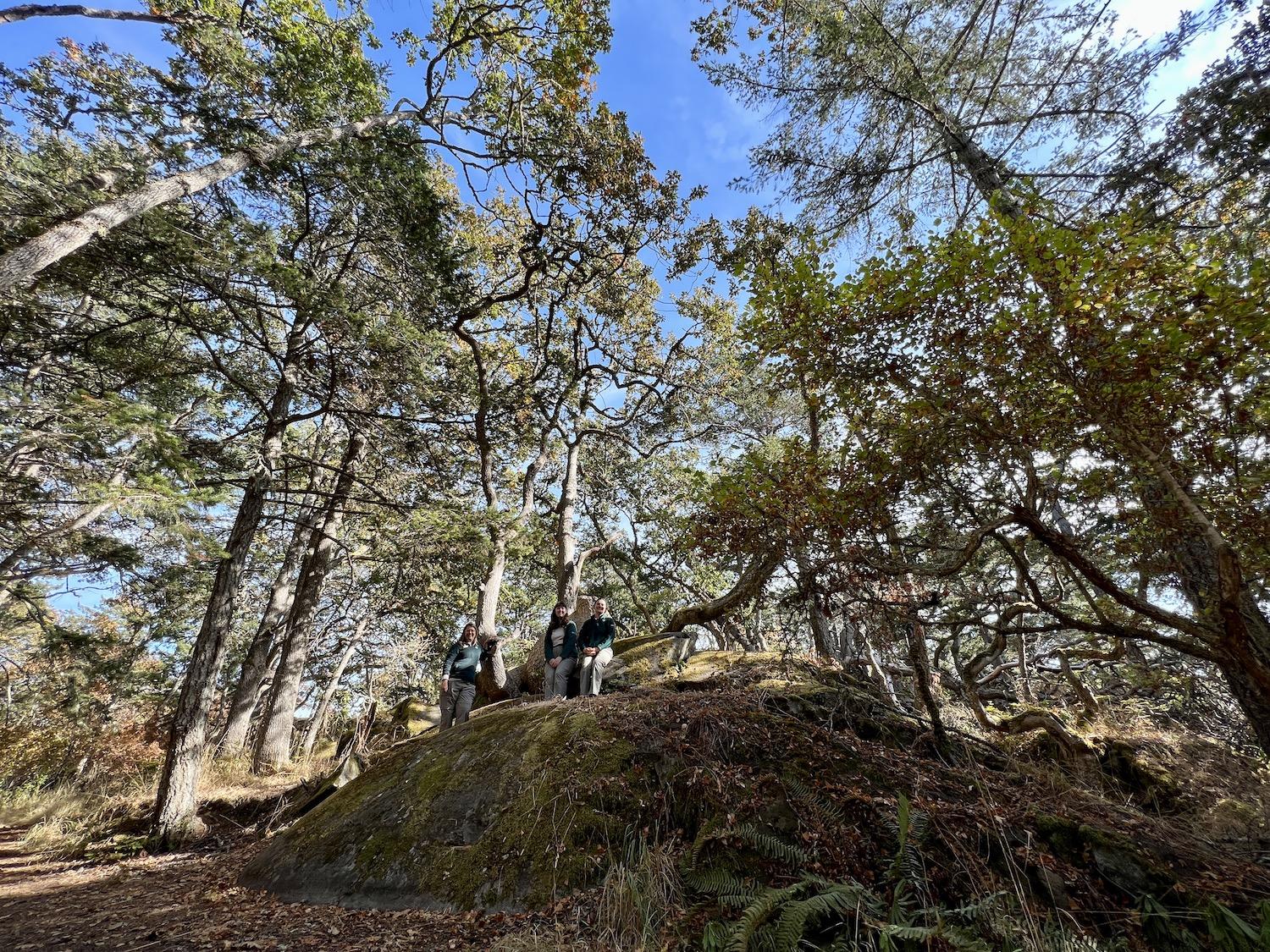
Parks Canada's Aimée Pelletier, Anna Lee and Ashley Everitt pose by the Gnarly Oak at Fort Rodd Hill and Fisgard Lighthouse National Historic Sites/Jennifer Bain
Of all the spellbinding Garry oak trees at Fort Rodd Hill and Fisgard Lighthouse National Historic Sites, the most popular is the one known by staff simply as “the Gnarly Oak.”
It lives on a rocky outcrop in a lush shoreline forest along the Historic Nature Trail and it’s a bit of a superstar. Film crews who gravitate to Vancouver Island for its abundance of spooky locations have picked this big beauty with the expansive canopy for the fantasy horror television drama Van Helsing and the comedy series Scaredy Cats.
“It grew that gnarly way because it was looking for sunlight because it’s growing in area where it was shaded,” Aimée Pelletier, the site’s species at risk partnering and engagement officer, told me on an early fall tour.
“Garry oaks are definitely very spooky looking,” added interpretation coordinator Ashley Everitt. “Especially when they don’t have their leaves on.”

A Garry oak looms in the backdrop behind the Garry Oak Learning Meadow at Fort Rodd Hill/Jennifer Bain
Based in Colwood and 20 minutes from downtown Victoria, British Columbia, this former military site with a popular lighthouse also protects endangered Garry oak ecosystems. In Canada, only three per cent of these ecosystems remain in a natural state and they’re only found in the southwest corner of this province.
The short nature trail that’s home to the Gnarly Oak follows a former military patrol trail on land that is the traditional territory of the Lekwungen-speaking peoples, today known as the Esquimalt and Songhees Nations. They helped create the trail that showcases plants that have served as food and medicine, and the Royal BC Museum helped develop interpretive signage.
It's my first experience with Garry oaks (Quercus garryana) and I learned their abundant acorns attract wildlife such as black-tailed deer who in turn became easy targets for First Nations hunters. Garry oak wood was once used to make digging sticks and other tools.
When the First Nations were stewards of this land, Parks Canada explains, they used land management practices like prescribed burning to keep Coastal Douglas-firs from overtopping the Garry Oaks and shading them out. Colonization put an end to that helpful practice and so woodlands have replaced the open meadows where Garry oaks and flourished alongside Great camas (Camassia leichtlinii), a brilliant blue flowering plant with a storable source of starch. Its bulbs were a valuable resource for First Nations people who slow cooked them in pits and ate them immediately or dried them for storage or trading.

Songhees Nation Knowledge Holder Cheryl Bryce shows off culturally significant camas in the Garry Oak Learning Meadow/Shanna Baker, Parks Canada
The Garry oaks themselves — which grow from here down to northern California — may have to struggle to survive and do support insects, birds and animals, but are not a species at risk. What’s really important is their associated ecosystems that are being lost to development and invasive species. These include prairie meadows, rocky outcrop, vernal pools where water collects in winter, and maritime meadows along the ocean.
When I became one of the 70,000 people who visit Fort Rodd Hill each year, something Pelletier, Everitt and heritage presenter Anna Lee said while showing me around stuck out. They said the somewhat unsung national historic site “hits the big Parks Canada three in one spot.”
The 19-hectare (47-acre) site is a former artillery fortress with military bunkers, command posts and heritage buildings, and it has a causeway to the oldest lighthouse on the Canadian west coast — hence the long-winded name and fact that two historic sites share space here. But this is also clearly a nature site, and it boasts coastline and a marine conservation area.

Looking over the causeway from the Fisgard Lighthouse, you can see how the British disguised the existence of Fort Rodd Hill when it was a military fortress/Jennifer Bain
On the nature front, there’s an interesting back story.
From 1878 to 1956, a series of coast artillery fortifications guarded Victoria and the naval base in Esquimalt harbour. But when the British established this site, “they wanted it to blend in to the natural environment so it wasn’t visible from the water — so that’s why they left a lot of forest intact,” explained Pelletier. “It has protected a really important area of Garry oak meadow, and that’s why we still have some species at risk here.”
Parks Canada is doing active ecological restoration across the site, tackling invasive carpet burweed, keeping browsing deer at bay and throwing up "area closed: natural rehabilitation and fire protection zone" signs. Endangered barn swallows build mud nests or hunker down in artificial “ledges” provided by staff. Between 30 and 33 healthy baby swallows were born this year. By the Upper Battery lookout, an area is fenced to protect endangered Deltoid balsamroot, which is being grown on the site’s nursery and successfully replanted.
“Although Fort Rodd Hill was never attacked, a war in the woods is being waged today,” one sign on the nature trail warns visitors. Introduced species like English Ivy and Daphne Laurel are forcing native and rare species to fight to survive, and it’s getting harder for the Esquimalt and Songhees people to find traditional foods and medicines. The signs urges visitors to preserve habitat, garden with native plants, remove introduce species, get involved and encourage others.

Military buffs will love exploring the batteries at Fort Rodd Hill/Jennifer Bain
Which brings us to the Garry Oak Learning Meadow.
This space, near the entrance to the site, was just manicured lawn until 2009 when it was transformed into wildflower meadows and woodland and fenced to keep the deer out. Hundreds of volunteers have devoted time over the years to restoring the rare ecosystem.
Coast Salish artist Tom LaFortune of the Tsawout First Nation carved the wooden entranceway to the meadow. It shows two figures, a man with his mouth open in greeting and a woman, both wearing blankets to represent the gathering of foods and medicines. To illustrate how First Nations people once hunted in Garry oak meadows for acorn-loving deer and harvested camas plants for their edible bulbs, LaFortune carved those things into the archway along with consumption plants (Lomatium nudicaule), which has antibiotic properties and is also known as bare-stem desert parsley.

At the Garry Oak Learning Meadow, Parks Canada's Anna Lee, Aimée Pelletier and Ashley Everitt stand under the welcome arch carved by Tom LaFortune/Jennifer Bain
Inside the meadow, which was winding down for the year when I visited, there’s a conservation nursery that grows native plants, species at risk and culturally important plants for Fort Rodd Hill and other Parks Canada and city sites. The visitor center hands out The Garry Oak Gardener’s Handbook.
Mindful that most visitors make a beeline for the picture-perfect 1860 lighthouse, Parks Canada tries to entice people to walk through the Garry oak meadow as they leave. “The most beautiful way to exit the site is through the meadow,” a sandwich board sign implores visitors.
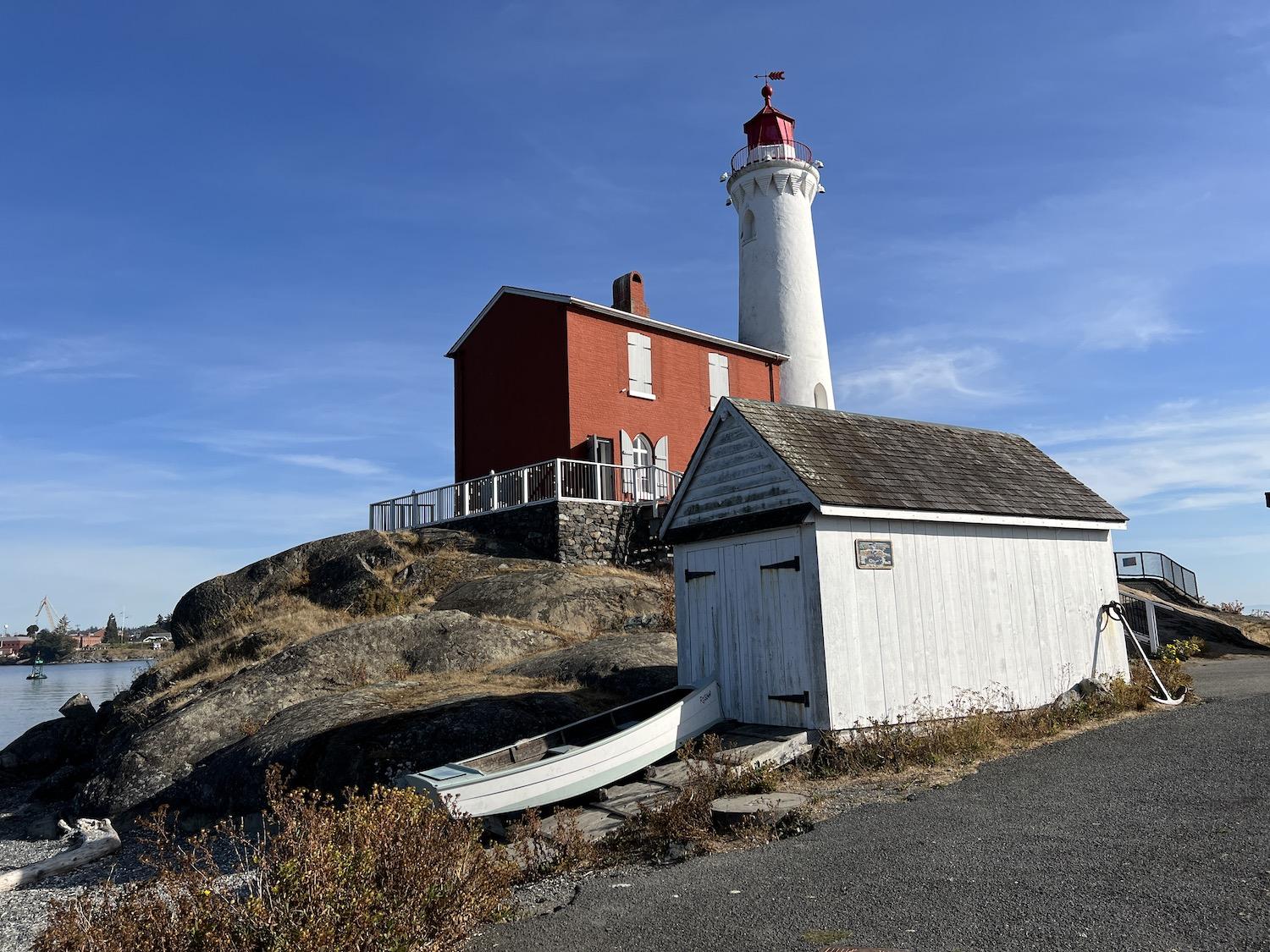
Fisgard Lighthouse is a big draw, and it's near tidal pools that are a favorite spot for interpretive staff and visitors/Jennifer Bain
Fort Rodd Hill has long been considered a place of community.
When Canada took control of it in 1906, it became a militia site where local men trained to defend their homes and community. Now it’s many things to many people. It's a hotspot for school groups studying intertidal life cycles and world wars. It's a popular wedding venue with shockingly affordable fees. It's a place to explore the inside of a lighthouse, comfort camp in an oTENTik (A-frame cabin/tent hybrid), stroll on a quiet beach or take a selfie with a glacial erratic.
It's also now part of the Whale Trail, a network of more than 100 sites along the Pacific coast from B.C. to California where people can watch sea mammals from shore for free or for a low fee. Getting connected to that project was Lee’s baby and she said more than 10 killer whales were spotted here in the Strait of Juan de Fuca this summer.
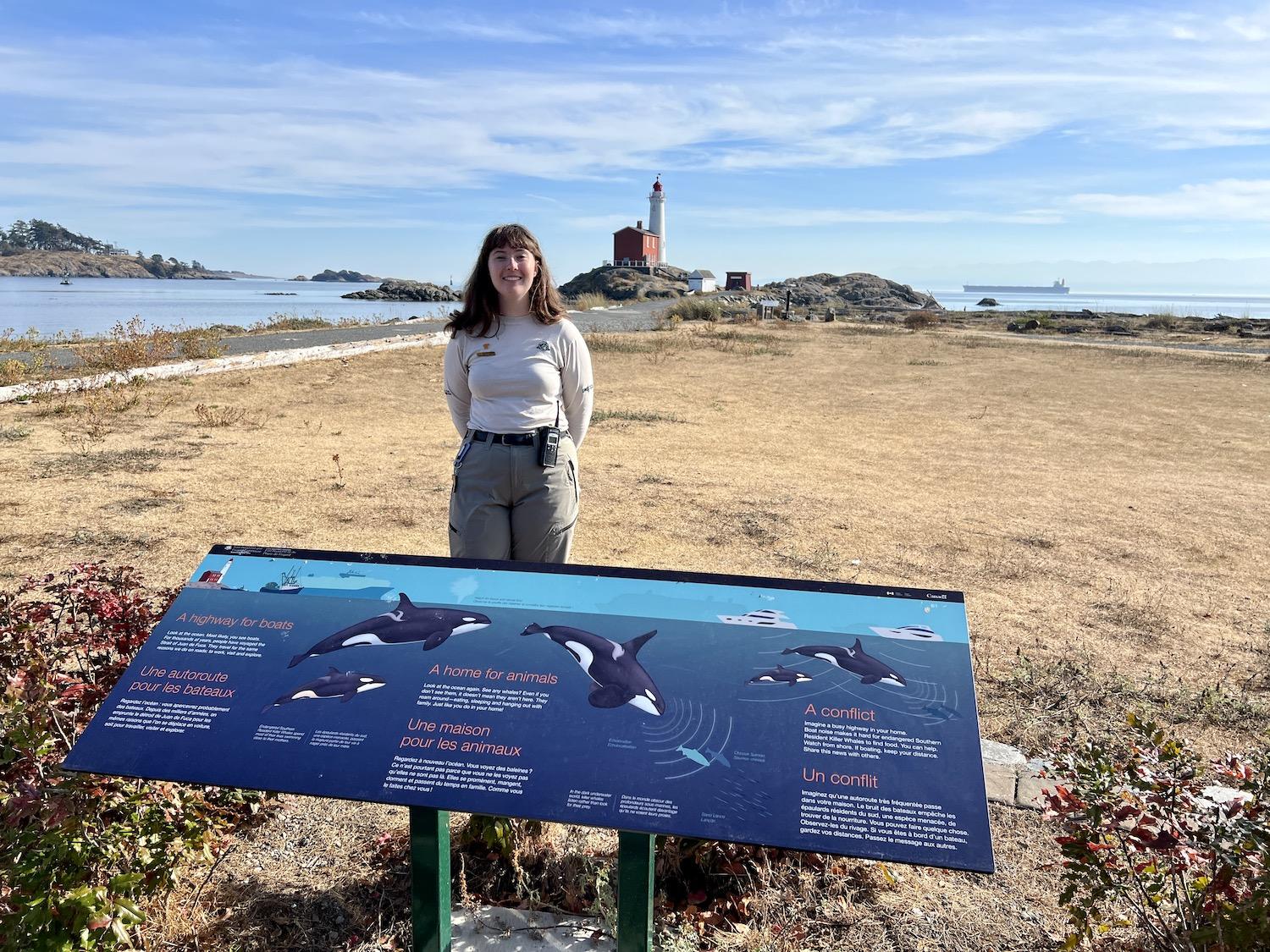
Heritage presenter Anna Lee stands by new signage that show that Fort Rodd Hill is part of the Whale Trail and a place to watch for sea mammals from shore/Jennifer Bain
While many national historic sites in Canada are seasonal, this one runs year-round thanks to mild winters and good weather.
The grounds and washrooms are open daily. The lighthouse and historic buildings are open daily from May 1 to Oct. 15 and on weekends the rest of the year. Most interpretive programming happens in the summer.
I saw a lot on my whirlwind trip through this multi-faceted site. But there were two things I missed during my September visit — Northern Alligator Lizards and invasive species ice cream.

A Northern Alligator Lizard basks in the sun on the shoulder of Alex Semple/Alex Semple, Parks Canada
Alligator lizards (not to be confused with invasive European Wall Lizards that dominate in the city) are a favorite of assets team member Alex Semple who drops everything when he spots one and said they generally keep to themselves in rocky/grassy forest clearings and eat slugs, snails, crickets, spiders, beetles, moths, small insects and even baby mice.
“They really are a treasure,” Semple said via email.
“They can be handled if one is confident and careful, and in my experience, usually become quite docile shortly after they discover how warm our hands are. I had one climb right up onto my shoulder and just bask for a half hour while I was able to walk around site and tell guests and coworkers about them. It was wild. Another one wasn’t even bothered by my pulling a half dozen ticks from in between its scales and even a couple within its ear canal. That one seemed pretty thankful for the unusual spa treatment.”
I looked in vain for the lizards and vowed to return when it's warmer and "the lizard whisperer" is working.
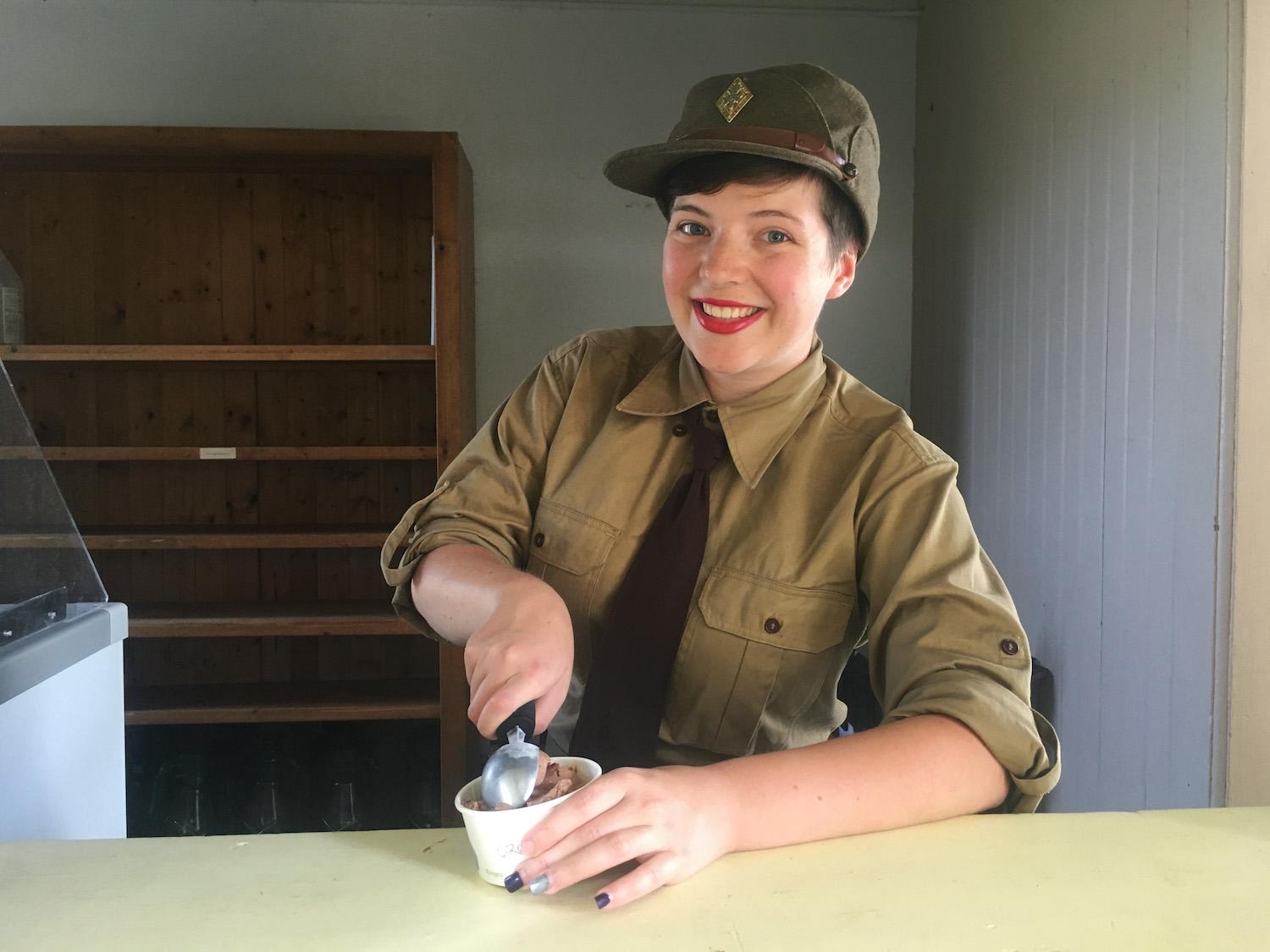
Every summer, Parks Canada staff serve signature ice cream flavors from the historic canteen at Fort Rodd Hill/Parks Canada
I also need to try the limited-edition ice cream that Parks Canada commissions Victoria’s Parachute Ice Cream to make and then sells in its historic canteen beginning in June. Signature flavors inspired by the World War II ration period include Chocolate Ration Cake and Apple Cider Oatmeal, but what really appeals is Himalayan Blackberry made from a delicious but invasive species found on site.
“The best way to get rid of an invasive species is to eat it,” said Everitt.
Alas, it was sold out for the season so I left Fort Rodd Hill without a sugar note, but after taking note of an interesting steel bin by the gated exit.
"Did you know that shells, sticks and rocks are important parts of the ecosystem here?" a sign asked. "Shells are homes for crabs and fish; moss and lichens need rocks to grow on and sticks provide hiding places for slugs and bugs. Please leave everything you found today in this box and we will return it to where it belongs. Go to the kiosk and get a small prize instead."
Of course, it's actually illegal to remove anything from a national park or national historic site — even a shell, stick or rock. But this is a much nicer way of getting that conservation message across.
While You’re In Victoria:
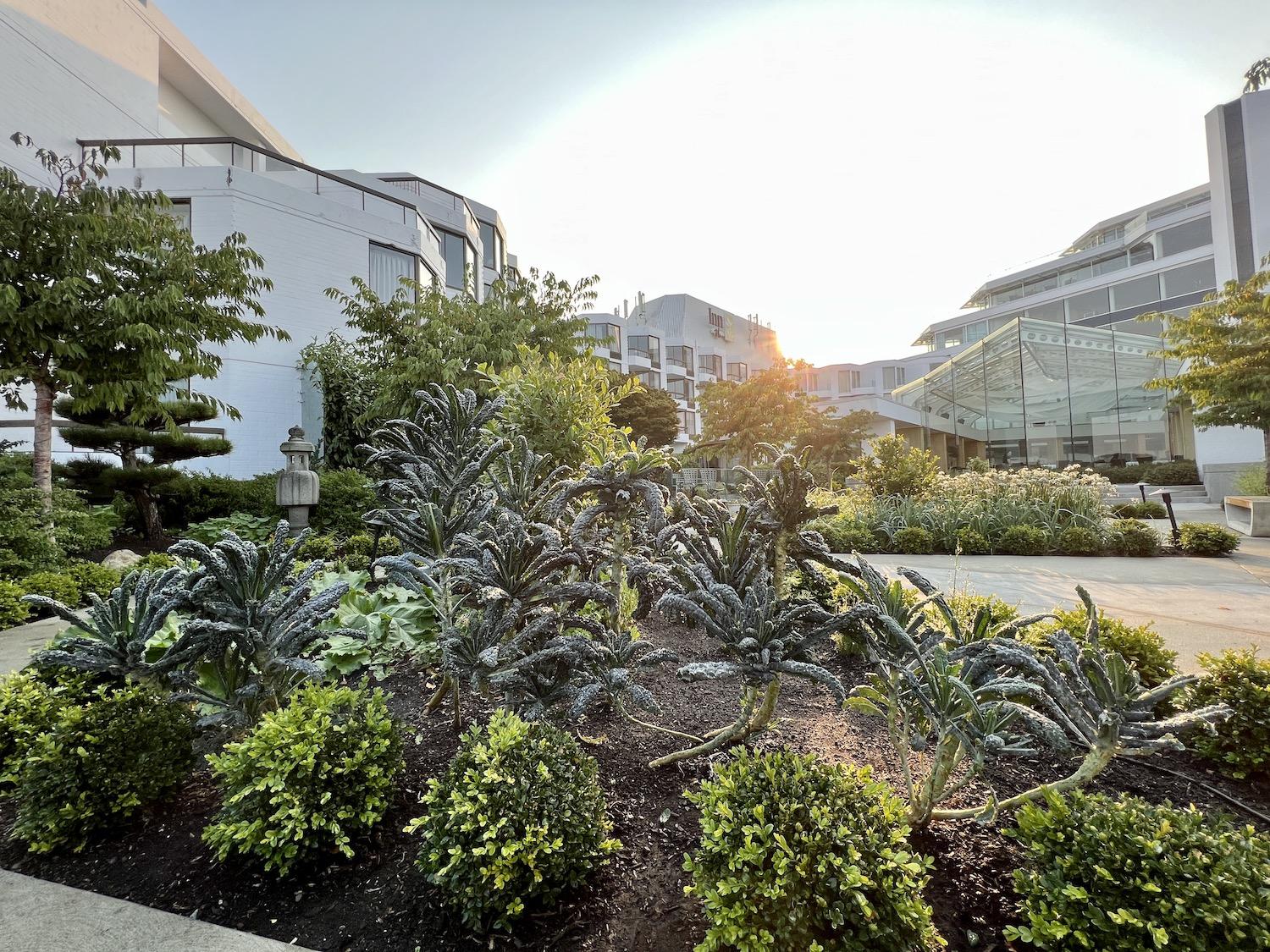
Kale and other edibles that find their way on to the menu are grown in the gardens at the Inn at Laurel Point in Victoria/Jennifer Bain
The Inn at Laurel Point, which sits on six acres of parkland on a peninsula at the entrance of Victoria’s Inner Harbour, became B.C.’s first carbon neutral hotel in 2009, uses hydrothermal technology to cool rooms with ocean water, and is a signatory to the Climate Pledge. With an annual audit by Synergy Enterprises, the hotel measures and reports its emissions and then offsets them (currently with a donation that supports the Great Bear Rainforest). The independently owned and operated hotel founded by Artie and Paul Arsens is unusual because it’s now run by a local trust as a social enterprise. The original four-storey Laurel Wing was built by Delta Hotel in the 1970s and has 136 rooms. The iconic six-storey Erickson wing, designed by Canadian architect Arthur Erickson to look like a ship coming into port and completed in 1989, has 65 rooms. An extensive kitchen garden provides herbs, edible flowers, fruits and vegetables for the Aura Waterfront Restaurant + Patio and can be toured as part of the newly landscaped garden and grounds.

 Support Essential Coverage of Essential Places
Support Essential Coverage of Essential Places



